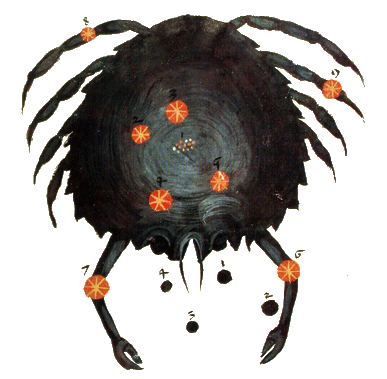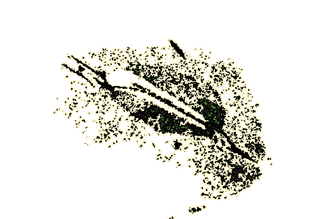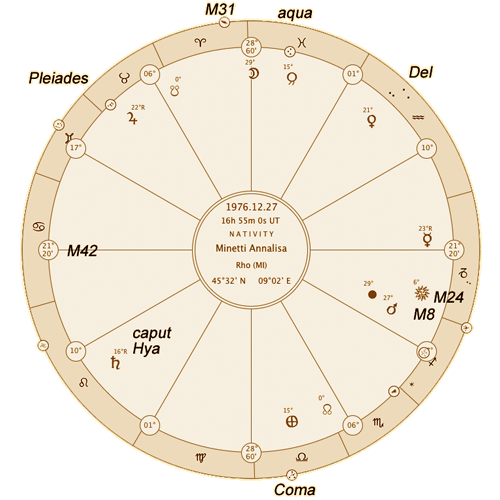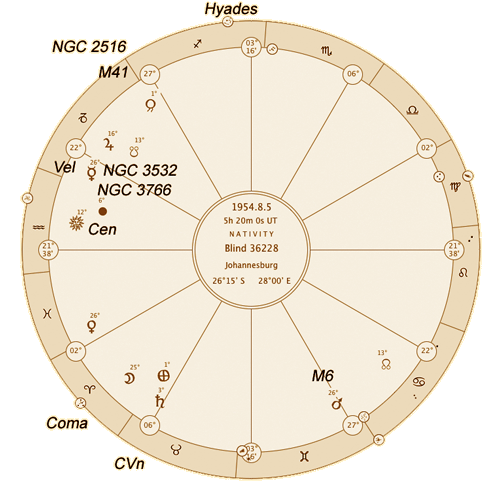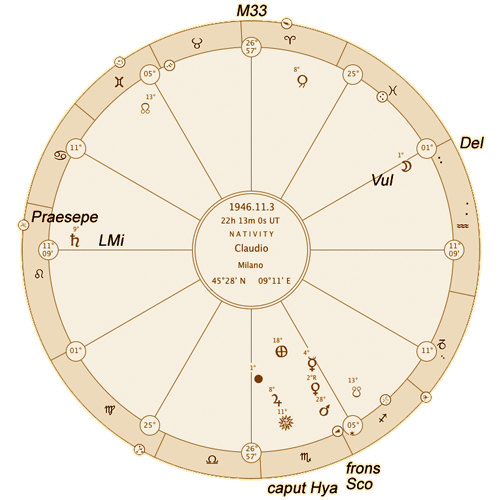Marco Fumagalli
The dark skyAncient and modern nebulae[1].
English translation by Margherita Fiorello
The ancient concept of "nebula"
In the ancient astronomical catalogs are present some stars called "nebulae" or "nebulous stars": they are celestial objects difficult to observe to the naked eye because they emit a very weak light, not punctiform as common stars. This optical characteristic has a precise astrological significance: the nebulae engaging sight may mean some "darkness" in those who are born, if they occupy important positions in the nativity: the darkness will manifest in eyes, soul, actions, etc.., according to the different astrological significators involved with the nebulae. Even today astronomy describes some non-stellar objects in the sky[2], whose observation engages sight and requires the use of more or less powerful binoculars or telescopes. But the point of view has changed: what matters to the modern astronomer is not the appearance but the object's physical character, its chemical composition, age, position in the galaxy or universe. |
The constellation of Cancer, |
An example may immediately help to clarify the difference in perspective: if two or three small stars appear very close together, so that the eye hardly distinguishes and perceives them as a set of light escaping a well defined vision, the ancient astronomer will tell you we are in presence of a "nebula", the modern rather will not say anything, unless they are really close each other, belonging to the same stellar group sharing age, physical and chemical characteristics, mutual gravitational force etc.. If they look close because the simple fact that their light projections correspond in respect to the Earth, this is of no interest to the modern scientist.
Andromeda "nebula" (Chambers GF |
Visible celestial objects of non-stellar nature today are classified into three broad categories:
In each of these categories there are naked eye objects which in antiquity have been called "nebulae". Compared to the old nebulae, however, are excluded the small asterisms, patterns of two or more stars the eye can hardly distinguish. |
Averted vision
All dim and no punctiform light celestial objects are more brilliant when observed with averted vision (better known as "out of the corner of the eye") that is not directly turning the look to the object but to the slight right or left, in order to receive its light in the lateral part of the retina.
This depends on the particular distribution of the two types of visual receptors in the retina: the rods and cones. The cones are responsible for visual acuity, are very sensitive to colors, not very sensitive to light and are mainly present in the central part of the retina; rods are insensitive to color, contribute to a lesser extent the visual acuity, but they are very sensitive to light and are especially present in the lateral sides of retina.
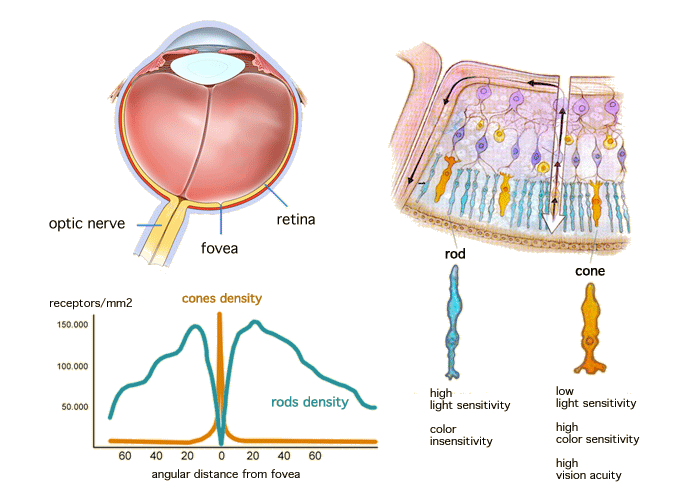
For example, a star cluster as Pleiades, if observed with averted vision, appears more blurred and indistinct in color but much wider and brighter.
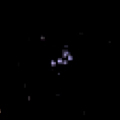 |
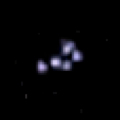 |
| direct vision | averted vision |
Some very weak objects are completely invisible using direct vision while appear as dim spots with averted vision. Since this increase in brightness with averted vision also occurs with small asterisms (like the Water of Aquarius o the Eye of Sagittarius) we can define ancient nebulae as all the celestial objects that take advantage of averted vision. If looking at the night sky, we see a light which greatly varies moving our eyes, we are in front of a nebula.
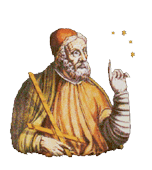
Ptolemy's nebulae
Ptolemy in the Almagest uses seven times the term νεφελοειδής, nebulous, cloudly, like a cloud (νεφέλη). The seven Ptolemy's nebulae are the following:
| 1) The right hand of Perseus | two open clusters close to each other, NGC 869 and NGC 884 Persei. |
| 2) Præsepe | open cluster M44 Cancri. |
| 3) Coma Berenices | open cluster Mel 111 Comae Berenices. |
| 4) The sting of the Scorpio | open cluster M7 Scorpii. |
| 5) The knee of the Swan | asterism, ω1 and ω2 Cygni. |
| 6) The neck [head] of Orion | asterism, λ, φ1, φ2 Orionis. |
| 7) The eye of Sagittarius | asterism, ν1 and ν2 Sagittarii. |
Of these seven nebulae, only the first four are now recognized as non-stellar objects, the others are simple asterisms[4]. Perseus'right hand and Praesepe were already present as nebulae in Hipparchus' catalog (second century. b.C.), while Coma Berenices and the sting of the Scorpio are Ptolemaic additions[5].
In the third book of the Quadripartite, Ptolemy talks again about "nebulous clusters", in the chapter on diseases and illnesses of the body:
«The eyesight, and one of the eyes, is damaged when the Moon is by itself upon the aforesaid corners, or joined to the Sun or full, or when it is configured to the Sun, in any other proportional aspect, also applying to one of the nebulous clusters in the zodiac, such as the Crab Nebula, the Pleiades in Taurus, the Arrow in Sagittarius, the Sting of the Scorpio, the parts of Leo near the Coma Berenices or the Pitcher of Aquarius»[6].
Compared to the list of the Almagest three more nebulae have been added:
| 8) The Pleiades | open cluster M45 Tauri |
| 9) The Arrow of Sagittarius | open cluster M8 Sagittarii[7] |
| 10) The Water of Aquarius | asterism, ψ1, ψ2, ψ3 Aquarii. |
and four less: the hand of Perseus, the knee of Cygnus, the neck of Orion and the eye of Sagittarius. The missing nebulae, with the exception of the eye of Sagittarius[8], are all very distant from the ecliptic, and this is due to the fact that in his astrological treatise Ptolemy pays especially attention to the zodiacal belt, while in the Almagest he describes the whole sky[9].
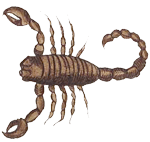
The stars of azemena degrees
Ptolemaic nebulae of the zodiacal belt constitute almost all the azemena degrees catalog of degrees, from the Arabic zamānat, chronic infirmity or incurable illness . These zodiacal degrees are considered harmful to the body, especially for eyes, since their longitude corresponds to nebulae or small asterisms[10]. These degrees can be found in the texts of Antiochus[11], Rhetorius[12]and the Anonymous of 379 AD[13]. Compared to the Ptolemaic zodiacal nebulae there are only two additions, the forehead of the Scorpio and the spine of Capricorn, and again they correspond to asterisms or star clusters[14]:
| Præsepe | 9°, 15° Cnc (with Asellii) | Almagest, Tetrabiblos |
| Coma Berenices | 18°, 27°, 28° Leo | Almagest, Tetrabiblos |
| The sting of the Scorpio | 25° Sco, 1° Sgr | Almagest, Tetrabiblos |
| The eye of Sagittarius | 18°, 19° Sgr | Almagesto |
| The Pleiades | 6°, 7°, 8°, 10° Tau | Tetrabiblos |
| The Arrow of Sagittarius | 7°, 8° Sgr | Tetrabiblos |
| The Water of Aquarius | 18°, 19° Aqr | Tetrabiblos |
| 11) The forehead of the Scorpio | 9° Sco | asterism, β, δ, π Scorpii, with open cluster and reflection nebula |
| 12) The spine of Capricorn | 26°, 29° Cap | asterism, ε, κ, Capricorni asterism, ζ Capricorni |
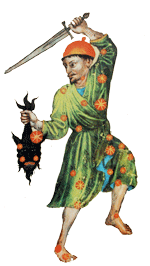
The nebulae of al-Sufi
In the tenth century the Persian astronomer 'Abd-al-Rahman al-Sufi, in his Book of Stars (964 AD), lists eight nebulae, five of which are already present in the Almagest: the hand of Perseus, Praesepe, the sting of the Scorpio, the eye of Sagittarius, the neck of Orion. Compared to Ptolemy al-Sufi skips Coma Berenices and the knee of Cygnus, but introduces three very important new nebulae:
| 13) Andromeda nebula [15] | galaxy M31 Andromedae |
| 14) Al-Sufi's nebula | open cluster Collinder 399 Vulpeculae |
| 15) Omicron Velorum cluster | open cluster IC2391 Velorum |
In addition, al-Sufi observed a great nebula cluster which he called al-Bakr, the White Ox of Southern Arabs, It is one of the most important objects in the Southern hemisphere: the Large Magellan Cloud, a large irregular galaxy appearing almost like a separate part of the Milky Way.
SUMMARY OF ANCIENT NEBULAE
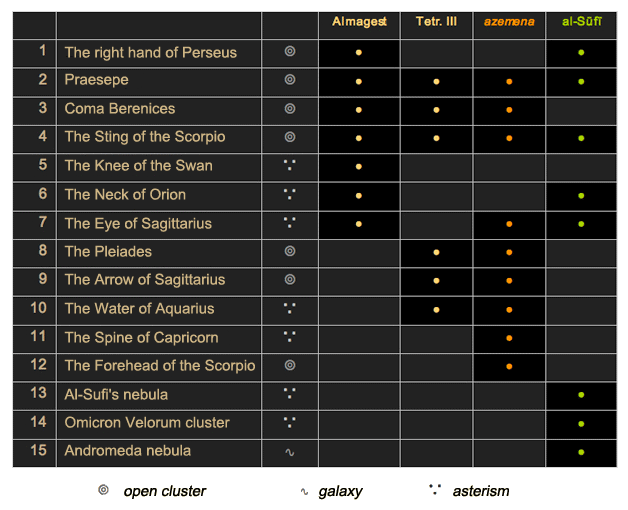
 Nebulae grow : Giovanni Battista Hodierna
Nebulae grow : Giovanni Battista Hodierna
With the invention of the telescope, the sky gradually turns fuller and fuller of nebulous objects, many of whom escaped to the observations of ancient astronomers although visible to the naked eye as dim spots.
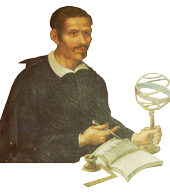 The most important observer of the "deep sky" in the seventeenth century was Giovanni Battista Hodierna, a Sicilian priest, physician, naturalist, astronomer and architect. Student of the Galilean school, Hodierna observed the sky with one of the first telescopes, perhaps given to him by Galileo himself, and collected his observations in De Admirandis Characteribus Coeli (1654), the first systematic catalog of nebulae in the old meaning of the term, thus including some small asterisms. We can say that Hodierna occupies a privileged place in the history of astronomical observations involving astrology, because he has a new tool that slightly enhances eyesight maintaining the same attention to the sky appearance.
The most important observer of the "deep sky" in the seventeenth century was Giovanni Battista Hodierna, a Sicilian priest, physician, naturalist, astronomer and architect. Student of the Galilean school, Hodierna observed the sky with one of the first telescopes, perhaps given to him by Galileo himself, and collected his observations in De Admirandis Characteribus Coeli (1654), the first systematic catalog of nebulae in the old meaning of the term, thus including some small asterisms. We can say that Hodierna occupies a privileged place in the history of astronomical observations involving astrology, because he has a new tool that slightly enhances eyesight maintaining the same attention to the sky appearance.
His nebulae classification is of great interest: he divides them into three categories according to their appearance to the naked eye and the telescope:

• Luminosæ as Pleiades , the eye distinguishes already some stars and the telescope can show many more;
• Nebulosæ, such as Præsepe[16]: the eye can only see an haze without distinguishing the star, which appears only with the telescope
• Occultæ, such as the Andromeda Nebula: the eye sees only a dim spot and not even the telescope can resolve it into stars.
Among the many new nebulae of Hodierna, we mention here only the most important ones.
| 16) The Hyades (luminosa)[17] | open cluster Mel 25 Tau |
| 17) α Persei cluster (luminosa) | open cluster Mel 20 Per |
| 18) The nebula in Orion's sword (luminosa) | open cluster M42 Ori, with emission and reflection nebula |
| 19) The tail of the Scorpio (luminosa) | open cluster NGC 6231, near ζ Sco |
| 20) The nebula above the sting of the Scorpio (nebulosa) | open cluster M6 Sco |
| 21) In the stern of the Ship | open cluster NGC 2451 Pup |
| 22) In the stern of the Ship | open cluster M47 Pup |
| 23) The little Beehive | open cluster M41 CMa |
| 24) The nebula of τ Canis Majoris | open cluster NGC 2362, CMa |
| 25) Above the head of Medusa | open cluster M34 Per |
| 26) The nebula in the Triangle | galaxy M33 Tri |
| 27) The nebula in Auriga | open cluster M38 Aur |
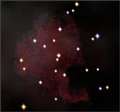 A method for extending the catalog
A method for extending the catalog
All nebulae which have been observed from Hipparchus to Hodierna's age, must be considered by astrologers, both near or far from the ecliptic, provided that they can rise and set at the observer's latitude[18]. Are there others to add? Certainly, if for no other reason than the Southern hemisphere was not observed and cataloged by Hodierna. We can browse modern astronomical catalogs in search of other star clusters, nebulae or galaxies bright enough to have an hint to the naked eye and even in this way, the catalog would greatly increase. But we will never find a catalog of small asterisms as the eye of Sagittarius, because they are no longer of any interest to astronomers of our time. Therefore it is required a method of analyzing the sky in order to find something fitting with the ancient idea of nebula, including small asterisms.
If we look at the sky with a small pair of binoculars, just enough to see magnitude 8 stars, the appearance of the nebula changes dramatically. Let's see what happens to one of the most famous, Præsepe:
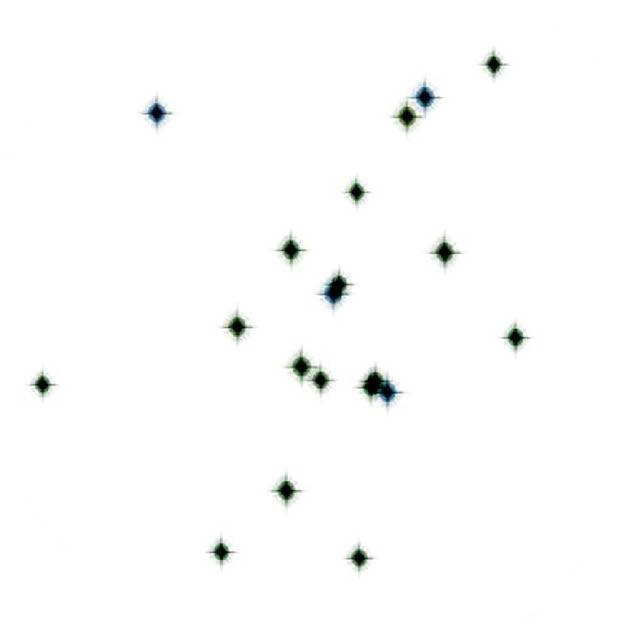 |
magnitude limit |
stars number |
6.50 |
3 |
|
7.00 |
10 |
|
7.50 |
14 |
|
8.00 |
20 |
Praesepe is composed by hundreds of stars, but these 20 are the ones emitting the brighter light and contribute more than others to create the nebulosity the eye perceives even if unable to distinguish the single stars. The first three are theoretically visible to the naked eye[19]. Let us now numerically evaluate data taking the magnitude 8 as limit . We are basically looking for a "light concentration index" applicable to any set of stars[20].
First we calculate in sq.deg the surface we are considering, by measuring the distance between the extreme stars: 0°.75 in width and 0°.733 in height = 0.55 square deg. Now take note of the magnitudes of the 20 stars, and calculate the total (TM):
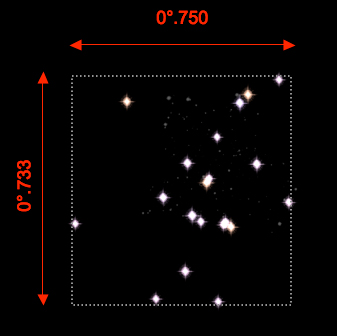 |
sigla della stella |
m. | |
| TYC1395-2711-1 | 7,28 | ||
| TYC1395-1993-1 | 7,43 | ||
| TYC1395-1928-1 | 7,43 | ||
| TYC1395-1677-1 | 7,43 | ||
| TYC1395-2006-1 | 7,56 | ||
| TYC1395-2198-1 | 7,62 | ||
| TYC1395-2321-1 | 7,75 | ||
| TYC1398-128-1 | 7,75 | ||
| TYC1395-1721-1 | 7,90 | ||
| TYC1395-2003-1 | 7,93 | ||
| TYC1395-2733-1 | 6,28 | ε Cnc, visible | |
| TYC1398-27-1 | 6,37 | visible | |
| TYC1395-2963-1 | 6,40 | visible | |
| TYC1395-2737-1 | 6,56 | ||
| TYC1395-806-1 | 6,59 | ||
| TYC1395-2544-1 | 6,62 | ||
| TYC1395-2024-1 | 6,75 | ||
| TYC1395-2552-1 | 6,75 | ||
| TYC1395-2605-1 | 6,81 | ||
| TYC1395-1804-1 | 6,87 | ||
| TM | 142,08 |
If all 20 stars were magnitude 8, we would have TM = 20 x 8 = 160. Because the brighter a star is the lower is its magnitude, we get the area total luminosity index (Φ) by subtracting 142.08 from 160:
Φ = ( stars number x 8) - TM
Φ = 160 - 142.08 = 17.92
This value indicates the actual light excess compared to the stars theoretical light value as determined if all of them had the magnitude we have taken as limit[21]. If now we divide the brightness we got by the surface area in square degrees (a) we find the brightness index per square degree (Ω)
Ω = Φ / a
Ω = 17.92 / 0.55 = 32.58
The index so calculated can reach very high values in the case of stars concentrated in a very small surface. For example, the Jewel Box (NGC 4755 Cru) gets a 1688 points index, more than 50 times higher than Præsepe and about 30 more than Pleiades. This is an open cluster in the Southern Cross, which has 7 stars with a magnitude lower than 8 concentrated in an area of only 5 'x 5' (0.007 square degrees). On the contrary, the index becomes very low in the case of extended nebulae, such as Coma, index 4.84, with 25 stars in an area of approximately 8 square degrees.
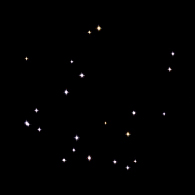 |
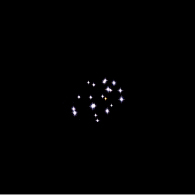 |
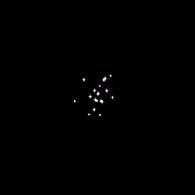 |
| Coma Berenices area 8°.36 Ω = 4.84 |
Pleiades area 0°.8 Ω = 55.58 |
Præsepe area 0°.55 Ω = 32.58 |
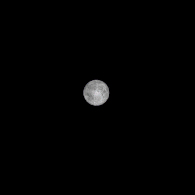 |
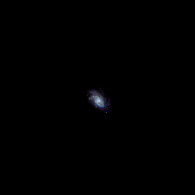 |
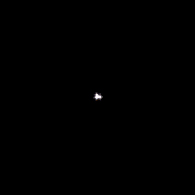 |
| Full Moon area 0°.2 |
Triangle Galaxy area 0°.07 Ω = 34.22 |
Jewel Box area 0°.007 Ω = 1687.59 |
A way to get less marked differences is relating the index to a minimum starting point, which can be represented by Pleiades, 0.80 square degrees, equivalent to four full moons.
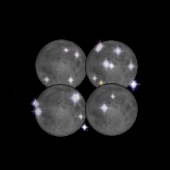
Adding the 0.80 square degrees area to each nebula, the formula for finding the index, which we call Ω 0.8, becomes the following:
Ω 0.8 = Φ / (0.8 + a)
where a is the nebula surface in square degrees. In Praesepe's case we get this new result:
Ω 0.8 = 17.92 / (0.8 + 0.55) = 13.27
In this way, very small nebulae are normalized, and those two with the highest index appear to be Pleiades (27.79) and the Orion Nebula (27.54). This result is very close to the visual perception looking at the sky.
Scrolling through the sky in search of new nebulous objects, and calculating for each one the Ω 0.8 index, we get the following list of 69 objects. All of them are visible to the naked eye and appear brighter using averted vision: therefore all are nebulae[22]
| Ω 0.8 | Nebula |
Name |
Const. |
Stars |
Area |
Φ |
||
| 27,79 | Pleiades | Mel 22, M45 | Tau | 21 | 0,800 | 44,46 | ||
| 27,54 | Orion Nebula | M42 | Ori | 20 | 0,491 | 35,55 | ||
| 20,55 | The sting of the Scorpio | M7 | Sco | 18 | 0,215 | 20,86 | ||
| 18,69 | The Diamond cluster | NGC 2516 | Car | 17 | 0,515 | 24,58 | ||
| 18,22 | The Hyades | Mel 25 | Tau | 11 | 0,600 | 25,51 | ||
| 16,30 | The neck of Orion | λ, φ1, φ2 | Ori | 8 | 0,396 | 19,50 | ||
| 15,42 | Auriga's asterism | 16, 17, 18, 19 | Aur | 7 | 0,183 | 15,16 | ||
| 14,72 | Southern Pleiades | IC 2602, θ Car | Car | 28 | 1,936 | 40,28 | ||
| 14,51 | Jewel Box | NGC 4755 | Cru | 7 | 0,007 | 11,71 | ||
| 14,37 | Leo Minor Asterism | 27, 28, 30 | LMi | 7 | 0,255 | 15,16 | ||
| 13,91 | ο Velorum cluster | IC 2391 | Vel | 20 | 1,024 | 25,36 | ||
| 13,58 | The tail of the Scorpio | NGG 6231, ζ | Sco | 10 | 0,020 | 11,14 | ||
| 13,38 | π Puppis association | Cr 135, π | Pup | 7 | 0,333 | 15,16 | ||
| 13,27 | Praesepe | M44 | Cnc | 20 | 0,550 | 17,92 | ||
| 12,42 | Puppis cluster | NGC 2451 | Pup | 14 | 0,850 | 20,49 | ||
| 12,16 | α Persei cluster | Mel 20 | Per | 14 | 1,333 | 25,94 | ||
| 11,87 | σ Persei cluster | σ | Per | 6 | 0,161 | 11,40 | ||
| 11,31 | The Water of Aquarius | ψ1 ψ2 ψ3 | Aqr | 3 | 0,400 | 13,57 | ||
| 11,27 | Velorum Asterism | HIP 48374 | Vel | 5 | 0,300 | 12,40 | ||
| 10,58 | Asterism under the head of Hydra | HIP 41307 | Hya | 3 | 0,043 | 8,92 | ||
| 10,49 | Asterism in the Triangle | γ, δ, 7 | Tri | 3 | 0,147 | 9,94 | ||
| 10,35 | Carina cluster | NGC 3293 | Car | 7 | 0,002 | 8,30 | ||
| 9,66 | The knee of the Swan | ω1, ω2 | Cyg | 6 | 0,204 | 9,69 | ||
| 9,56 | η Carinae cluster | NGC 3372 | Car | 26 | 2,053 | 27,29 | ||
| 9,39 | τ Canis Majoris cluster | NGC 2362, τ | CMa | 3 | 0,076 | 8,23 | ||
| 9,35 | The arrow of Sagittarius | M8 - NGC 6530 | Sgr | 7 | 0,126 | 8,66 | ||
| 9,33 | Trifid Nebula | M20, NGC 6514 | Sgr | 8 | 0,340 | 10,64 | ||
| 9,28 | Canis Minor asterism | β, γ, ε | CMi | 5 | 0,611 | 13,09 | ||
| 9,02 | Vulpecula asterism | 18, 19, 20 | Vul | 5 | 0,116 | 8,26 | ||
| 8,91 | Centauri asterism | HIP 56573 | Cen | 3 | 0,064 | 7,70 |
||
| 8,90 | Eridanus asterism | ρ1, ρ2, ρ3 | Eri | 3 | 0,064 | 7,69 | ||
| 8,58 | The Wishing Well cluster | NGC 3532 - C 91 | Car | 19 | 0,475 | 10,94 | ||
| 8,43 | al-Sufi's nebula | Collinder 399 | Vul | 11 | 1,204 | 16,89 | ||
| 8,43 | Andromeda asterism | 63, 64, 65, 66 | And | 4 | 0,434 | 10,40 | ||
| 8,40 | In the stern of the Ship | M47 - NGC 2422 | Pup | 11 | 0,165 | 8,11 | ||
| 7,78 | Pegasus asterism | 34, 35, 37 | Peg | 5 | 0,333 | 8,82 | ||
| 7,76 | The eye of Sagittarius | ν1 ν2 | Sgr | 3 | 0,043 | 6,54 | ||
| 7,70 | Velorum Cluster | NGC 2547 | Vel | 5 | 0,043 | 6,49 | ||
| 7,61 | ι Geminorum cluster | ι , 59, 64, 65 | Gem | 9 | 1,305 | 16,02 | ||
| 7,60 | The right hand of Perseus | NGC 869-884 | Per | 10 | 0,565 | 10,38 | ||
| 7,48 | Hercules asterism | 90 | Her | 3 | 0,045 | 6,32 | ||
| 7,24 | Aquila asterism | 51 Aql | Aql | 6 | 0,296 | 7,93 | ||
| 7,20 | Piscis Austrinus asterism | υ, μ, τ | PsA | 9 | 1,562 | 17,01 | ||
| 6,72 | Carina cluster | NGC 3114 | Car | 10 | 0,275 | 7,23 | ||
| 6,61 | φ Aurigae asterism | φ + *M38 | Aur | 11 | 1,647 | 16,17 | ||
| 6,60 | North America Nebula | NGC 7000 | Cyg | 23 | 3,870 | 30,80 | ||
| 6,44 | Above the sting of the Scorpio | M6 | Sco | 6 | 0,097 | 5,78 | ||
| 6,44 | Cygnus cluster | NGC 6871 | Cyg | 6 | 0,080 | 5,67 | ||
| 6,42 | Asterism under the tail of Hydra | 54, 55, 56 | Hya | 7 | 1,560 | 15,16 |
||
| 6,32 | Canes Venatici Asterism | 20, 23 | CVn | 4 | 0,944 | 11,02 | ||
| 6,29 | Centaurus cluster | NGC 3766 | Cen | 4 | 0,006 | 5,07 | ||
| 6,22 | "Delle caustiche" cluster | M24 - NGC 6603 | Sgr | 18 | 1,110 | 11,88 | ||
| 5,62 | Delphinus quadrilateral | α, β, γ, δ | Del | 16 | 5,338 | 34,50 | ||
| 5,58 | The Little Beehive | M41 - NGC 2287 | CMa | 9 | 0,179 | 5,46 | ||
| 5,55 | Cygnus cluster | M39 | Cyg | 7 | 0,122 | 5,12 | ||
| 5,24 | The Forehead of the Scorpio (π) | Sh2-1 | Sco | 13 | 3,423 | 22,11 | ||
| 4,99 | Omega Centauri | ω | Cen | 1 | 0,063 | 4,30 | ||
| 4,95 | ω Sagittarii asterism | ω, 59, 60, 62 | Sgr | 6 | 2,020 | 13,97 | ||
| 4,42 | Coma Berenices | Mel 111 | Com | 25 | 8,358 | 40,48 | ||
| 4,14 | Ophiuchus cluster | IC 4665 | Oph | 8 | 0,190 | 4,10 | ||
| 3,99 | The Andromeda galaxy | M31 | And | 4 | 0,653 | 5,79 | ||
| 3,92 | Cluster in Castor's foot | M35 | Gem | 3 | 0,111 | 3,57 | ||
| 3,88 | The spine of Capricorn (a) | ζ, 36 | Cap | 11 | 3,998 | 18,61 | ||
| 3,81 | 47 Tucanae | 47 | Tuc | 1 | 0,250 | 4,00 | ||
| 3,29 | The spine of Capricorn (b) | ε, κ | Cap | 14 | 4,469 | 17,35 | ||
| 3,07 | Above the head of Medusa | M34 | Per | 3 | 0,090 | 2,73 | ||
| 2,65 | Triangle Galaxy | M33 | Tri | 1 | 0,067 | 2,30 | ||
| 2,18 | Large Magellanic Cloud | LMC | Dor | 6 | 5,001 | 12,66 | ||
| 1,66 | Small Magellanic Cloud | SMC - NGC 292 | Tuc | 9 | 6,000 | 11,30 | ||
It is interesting to note that, if we calculate the index in a large area of sky away from the Milky Way, such as the one between Arcturus and the head of the Scorpio, we find 2160 stars within the magnitude 8 in an area of 2652 square degrees, and an index of light concentration equal to 0.77:
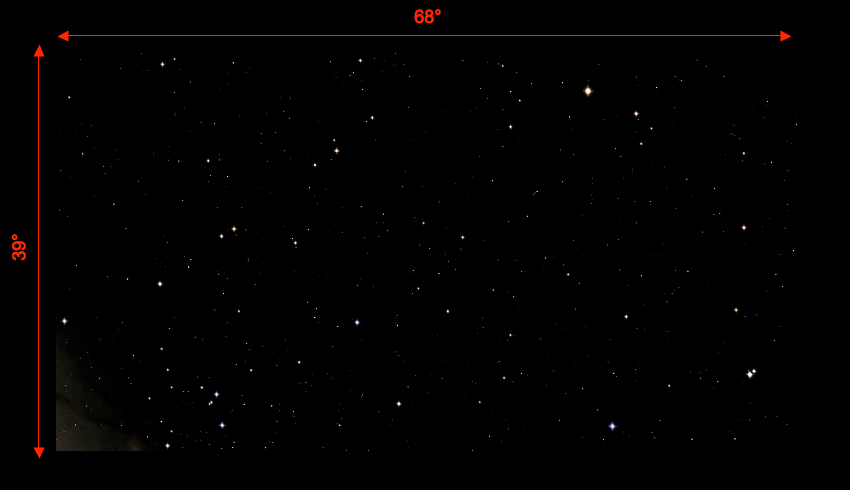
A rather dark sky area : index 0.77
If on the contrary in the same area we include Milky Way brighter area, the stars rise to 5253 and the index rises to 1.78. In fact, the Milky Way can be considered as a whole large nebula and all the items we listed, with the exception of the Small Magellanic Cloud, are over its average index.
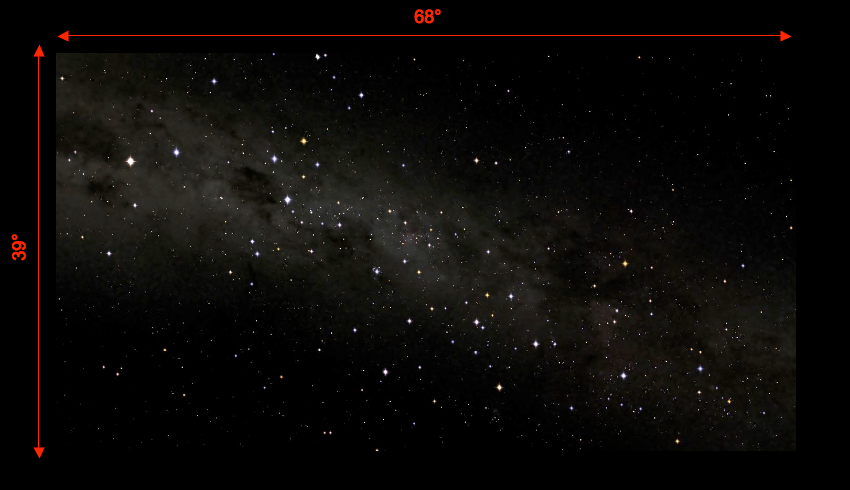
The same area, crossed by the Milky Way: index 1.78
Some of the new clusters and asterisms in this list have very Southern declinations and this may explain their absence in the ancient catalogs. Bright nebulae such as the Diamond Cluster or the Southern Pleiadescertainly would have not escaped to Ptolemy or al-Sufi if they were high enough on their horizons. However some absences are difficult to explain: for example, in the Charioteer's legs there is a very prominent small asterism (16, 17, 18, 19)absent in ancient catalogs, as well as ι Geminorum, even if it is in the middle of a Zodiacal constellation.
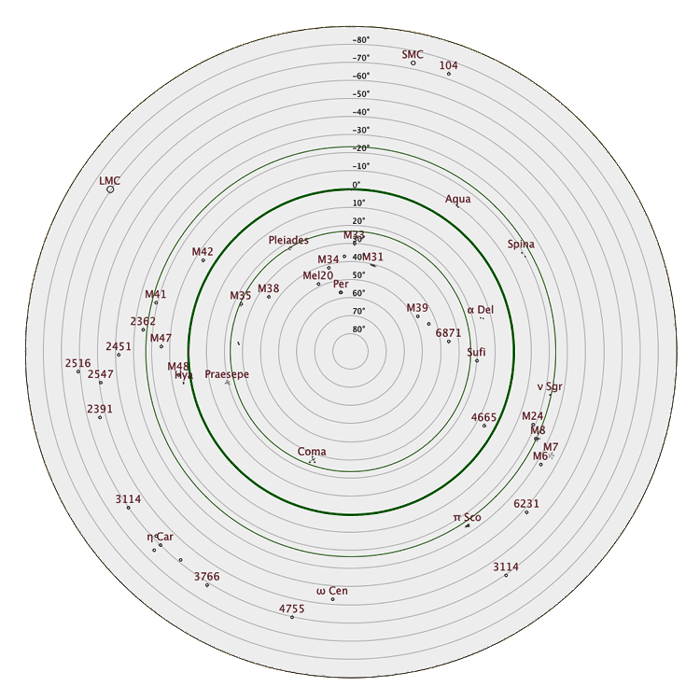
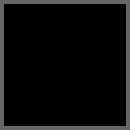 Nebulae and blindness
Nebulae and blindness
Although nebulae's harmful influence is not limited to the body, the easiest way to test them is to observe those nativities showing a damage to the eyesight. Since blindness is always associated to the intervention of one or more nebulae, if those we have found are really nebulae, we will have to find them highlighted in some way in the nativities of blind persons.
The 18 examples below are only limited to the presence of celestial objects in the most fitting places to receive their influence, without performing a full astrological judgment which would be necessary. Without a doubt among these places the Moon occupies the first place, and Ptolemy limited himself to it. But at the Moon should be certainly added other significators, such as the Sun, the two Lots, the lord of the Horoscope, the two malefic stars, and the two "noble" angles, Horoscope and Midheaven[23].
1) Aleandro Baldi Blind from birth. Greve in Chianti (FI), 43N35, 11E19, April 11, 1959, 16h30m UT, Horoscope: 6°08' Librae.
|
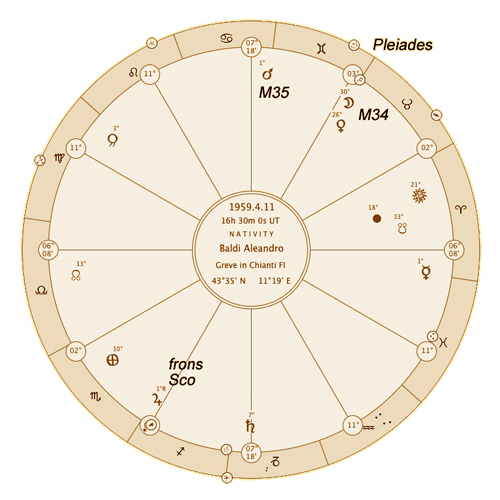 |
2) José Feliciano Blind from birth. Lares (Puerto Rico), 18N18, 66W53, September 10, 1946, 12h50m UT (-10m) Horoscope: 23°31 'Librae
|
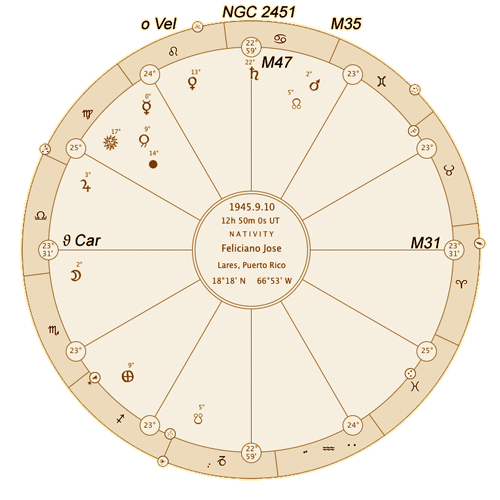 |
3) Stevie Wonder Blind from birth because of suffering in labor Saginaw (MI-USA), 43N25, 83W57, May 13, 1950, 21h25m UT (+10) Horoscope: 14°10' Librae
|
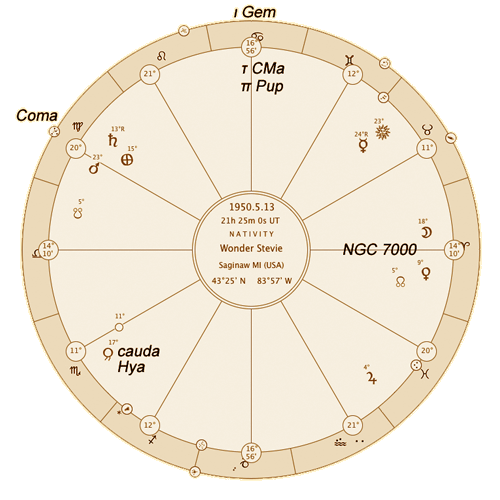 |
4) Harvey Yorke Born blind and autistic. Brighton (England), 50N50, 0W08, May 27, 2002, 0h15m UT Horoscope: 14°04' Aquarii
|
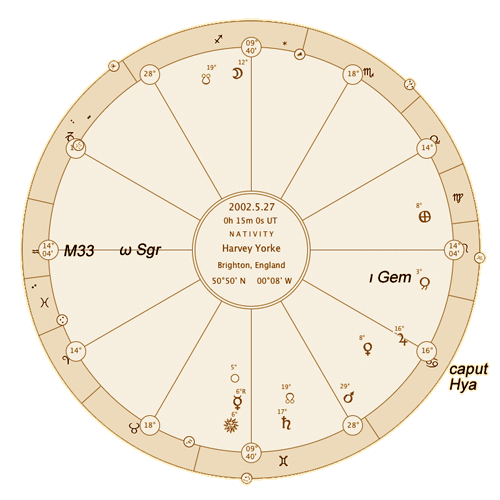 |
5) Jean Langlais Blind since the age of 2: glaucoma. The Fontenelle (France), 48N28, 1W30, February 15, 1907, 15h54m40s UT Horoscope: 10°18' Leonis
|
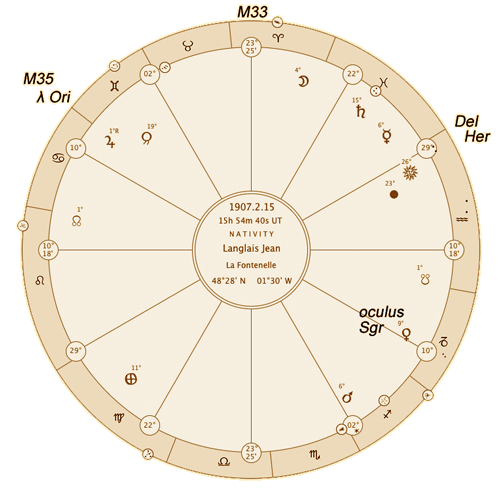 |
6) Louis Braille Blind since the age of 3: infection by accident. Coupvray (France), 48N54, 2E48, January 4, 1809, 3h48m48s UT Horoscope: 23°06' Scorpii
|
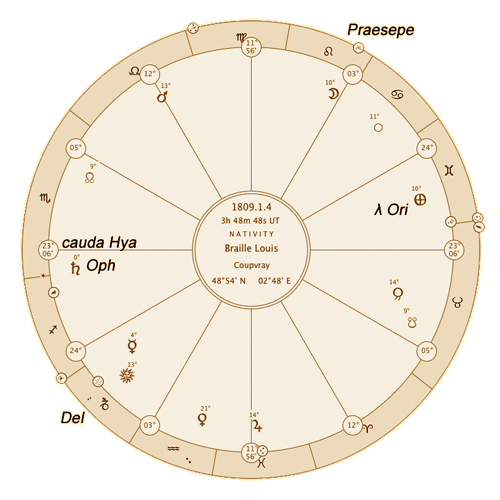 |
7) Ray Charles Blind since the age of 7: glaucoma. Albany (NY-USA), 31N35, 84W10, September 23, 1930, 5h51m30s UT Horoscope: 18°06' Cancri
In the 8th year, the Moon comes to the directed square of Mars, which is with the nebula, and the Sun to the square of Saturn. |
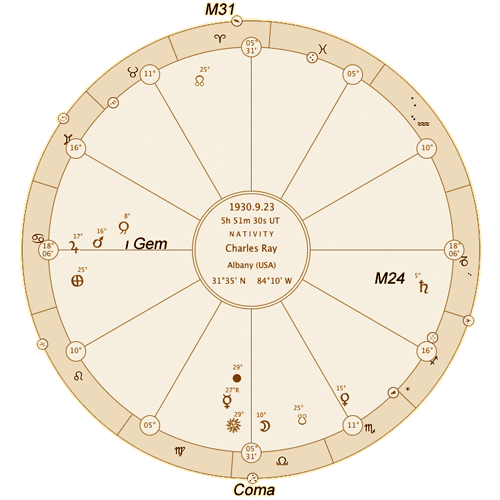 |
8) Veronica Blind since the age of 13 years: surgery for a brain tumor. Sesto San Giovanni (MI), 45N32, 9E14, October 17, 1954, 6h50m UT Horoscope: 5°52' Scorpii
Brain tumor and blindness when Saturn arrives to the horoscope (June 97) while the Moon is opposing Mars (Feb. 95) and Jupiter (March 98) which are with the nebula. |
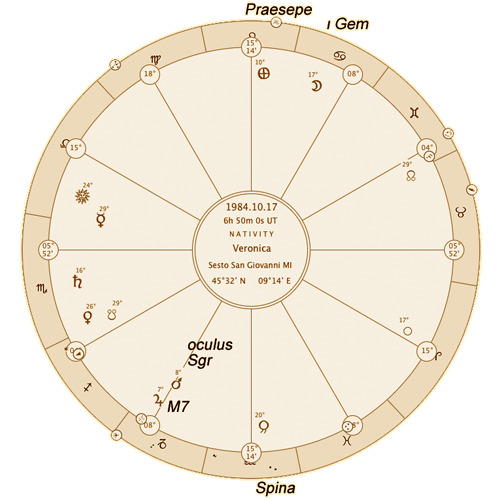 |
9) Andrea Bocelli Blind since the age of 12: head injury. Lajatico (PI), 43N28, 10E43, September 22, 1958, 4h10m UT, Horoscope: 17°27' Virginis
In the 13th year the degree 7°45' Aquarii, which has Mars' opposite declination (-18.33) arrives to the direction of the Moon.
|
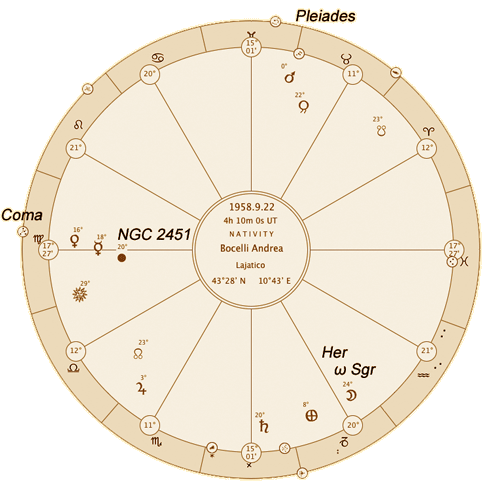 |
10) Blind 11919 source: AstroDatabank. Blind since birth and mentally retarded. Los Angeles (CA-USA), 34N04, 115W15, July 14, 1951, 4h18m UT Horoscope 17°03' Aquarii.
|
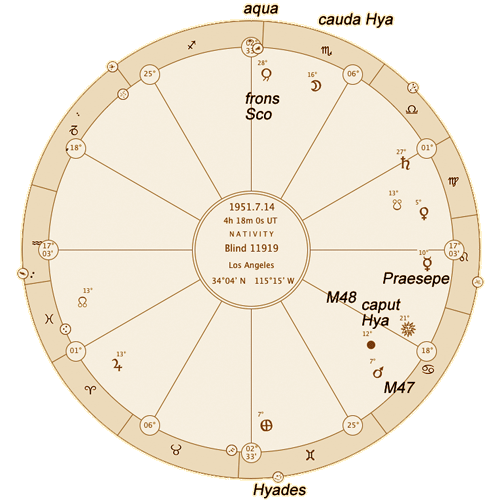 |
11) Annalisa Minetti She gradually loses sight from the age of 6 and at 20 is almost completely blind because of a retinitis pigmentosa with macular degeneration. Rho (MI), 45N32, 9E02, December 27, 1976, 16h55m UT, Horoscope: 21°20' Cancri
|
|
During the period of progressive vision loss, Andromeda nebula transits by direction on the Moon, reaching Daimon in the 20th year, when the Moon came to the square in mundo of Mars and Saturn and the parallel with the Sun. |
|
12) Blind 36228 source: AstroDatabank. Blind and mentally retarded. Johannesburg (South Africa), 26S15, 28E00, August 5, 1954, 5h20m UT, Horoscope 21°38' Aquarii
|
|
13) Blind 'G' source: Ufficiale[25] Blind since the age of 6 months. Rome, 41N54, 12E29, March 27, 1952, 7h00m UT Horoscope 21°42' Taurus
|
 |
14) Alex source: Ufficiale. Congenital glaucoma. Milan, 45N28, 9E11 - December 17, 1977, 9h52m UT (- 10m) Horoscope 12°27' Aquarii
|
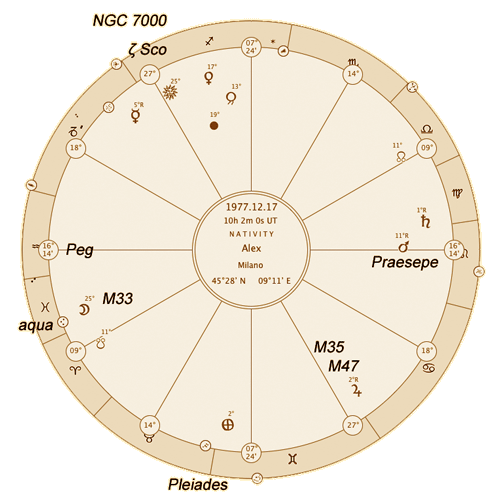 |
15) Hellen Keller source: AstroDatabank. Blind and deaf from the age of 19 months, for "brain fever." Tuscumbia (AL-USA), 34N43, 87W42, June 27, 1880, 21h37m10s UT (-15m38s) Horoscope 22°07' Scorpii
|
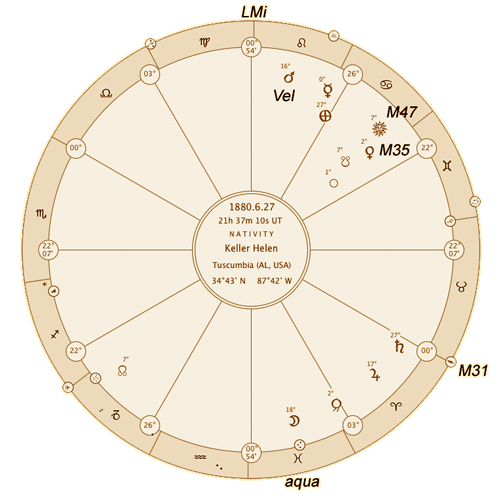 |
In the nineteenth month the Moon perfects its parallel in mundo with Mars, being with both nebulae in the nativity. In the revolution of the second year, the Moon is with ι Geminorum and receives the predominant square by both malefics in Taurus, being Saturn with α Persei cluster (Mel 20). |
|
16) Kirk R. Roland source: AstroDatabank. Blind since the age of two because an error in medical treatment[27]. Columbus (OH, USA), 39N57, 82W59 - August 7, 1935, 21h38m UT (-7m) Horoscope 26°06' Sagittarii
In 1937, the Moon and Saturn perfect by direction their mundane parallel.
|
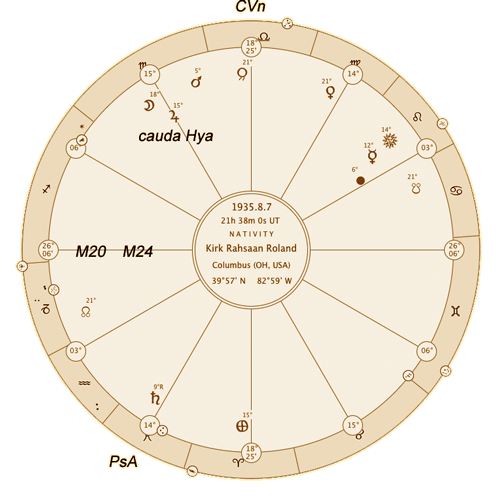 |
17) Giuseppe Borgatti source: AstroDatabank. Became blind at age 43 for glaucoma. Cento (FE), 44N43, 11E17 - March 17, 1871, 14h10m UT Horoscope 20° 58' Sagittarii.
|
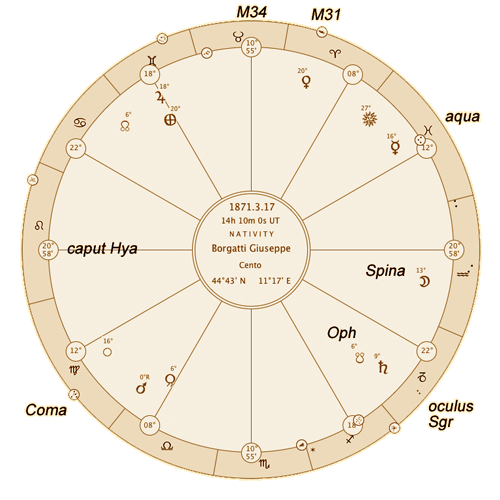 |
| In 1914, the Moon perfects the in mundo direction with Saturn, Mars to the parallel with the Moon, Venus and Mercury. The tenor becomes suddenly blind during a performance. | |
18) Claudio Source: author's archive. He lost his right eye at age 40 because of a badly treated infection. Milan, 45N28, 9E11, November 3, 1946, 22h13m UT Horoscope 11°09' Leonis.
In the spring of 1987, the sun arrives at parallel of Mars, which is with Scorpio forehead.
|
|
![]()
Conclusions
The nativities we showed seem to confirm that many of these objects deserve to be considered in the astrological survey as the nebulae known for centuries. In the 18 examples examined, we saw 48 of the 69 items of the catalog. Among these there are 16 appearing at least three times, for a total of 71 appearances, divided in the following way[28]:
Among the most common nebulae there are some with a high degree of light intensity (such as Pleiades or Praesepe) and others with a very low index (such as Andromeda Galaxy, the Triangle or Coma Berenices). This means that the index itself does not measure a nebula's harmfulness level but only its group membership. The method can be refined and the list can be further increased[29], but some of the new items we have so far identified already appear to claim their right of citizenship in a new astrological catalog of nebulae.

APPENDIX 1 - Table of nebulae's presence in the 18 nativities
| nebula | nativity |
number |
| Coma Berenices | 7 |
Wonder, Charles, Bocelli, Minetti, Blind 36228, Blind «G», Borgatti |
| M31, the Andromeda Galaxy | 6 |
Feliciano, Charles, Minetti, Blind «G», Keller, Borgatti |
| M35, in the foot of Castor | 5 |
Baldi, Feliciano, Langlais, Alex, Keller |
| Asterism under the head of Hydra | 5 |
Yorke, Blind 11919, Minetti, Borgatti, Claudio |
| Water of Aquarius | 5 |
Blind 11919, Minetti, Alex, Keller, Borgatti |
| Pleiades | 5 |
Baldi, Bocelli, Minetti, Blind «G», Alex |
| Praesepe | 5 |
Braille, Veronica, Blind 11919, Alex, Claudio |
| M47, Puppis cluster | 4 |
Feliciano, Blind 11919, Alex, Keller |
| ι Geminorum asterism | 4 |
Wonder, Yorke, Charles, Veronica |
| Asterism under the tail of Hydra | 4 |
Wonder, Braille, Blind 11919, Roland |
| M33, the Triangle Galaxy | 4 |
Yorke, Langlais, Alex, Claudio |
| The Dolphin quadrilateral | 4 |
Langlais, Braille, Minetti, Claudio |
| The Scorpio forehead (π) | 4 |
Baldi, Blind 11919, Blind «G», Claudio |
| M24 delle Caustiche cluster | 3 |
Charles, Minetti, Roland |
| ω Sagittarii asterism | 3 |
Yorke, Bocelli, Blind «G» |
| The eye of Sagittarius (ν1, ν2) | 3 |
Langlais, Veronica, Borgatti |
| Cluster in Ophiuchus (IC 4665) | 2 |
Braille, Borgatti |
| Puppis cluster (NGC 2451) | 2 |
Feliciano, Bocelli |
| Hercules asterism | 2 |
Langlais, Bocelli |
| Canes Venatici asterism (20, 23) | 2 |
Blind 36228, Roland |
| Leo Minor asterism (27, 28, 30) | 2 |
Keller, Claudio |
| Vela asterism (HIP 48374) | 2 |
Blind 36228, Keller |
| Vulpecula asterism in (18, 19, 20) | 2 |
Blind "G", Claudio |
| The Hyades (Mel 25) | 2 |
Blind 11919, Blind 36228 |
| North America Nebula (NGC 7000) | 2 |
Wonder, Alex |
| M34, the head of Medusa | 2 |
Baldi, Borgatti |
| The neck of Orion | 2 |
Langlais, Braille |
| The spine of Capricorn (ζ, 36) | 2 |
Veronica, Borgatti |
| o Velorum cluster (IC 2391) | 1 |
Feliciano |
| τ Canis Majoris cluster | 1 |
Wonder |
| Cluster in Centaurus (NGC 3766) | 1 |
Blind 36228 |
| Cluster in Cygnus (NGC 6871) | 1 |
Blind «G» |
| M48, Hydra cluster | 1 |
Blind 11919 |
| π Puppis association | 1 |
Wonder |
| Pegasus asterism (34, 35, 37) | 1 |
Alex |
| Centaurus asterism (HIP 56573) | 1 |
Blind 36228 |
| Piscis Austrinus asterism (υ, μ, τ) | 1 |
Roland |
| Triangle asterism (γ, δ, 7) | 1 |
Blind «G» |
| M41, the Small Hive | 1 |
Blind 36228 |
| The Wishing Well (NCG 3532) | 1 |
Blind 36228 |
| The Diamond cluster (NGC 2516) | 1 |
Blind 36228 |
| The tail of Scorpio (ζ) | 1 |
Alex |
| M42, the Orion Nebula | 1 |
Minetti |
| Trifid Nebula | 1 |
Roland |
| Southern Pleiades | 1 |
Feliciano |
| M6, over the sting of the Scorpio | 1 |
Blind 36228 |
| M7, the sting of the Scorpio | 1 |
Veronica |
| M8, the Lagoon nebula | 1 |
Minetti |
APPENDIX 2
Areas with the highest concentration of nebulae
in the 18 nativities examined
with a malefic |
25 |
with the Moon |
17 |
at the Midheaven |
15 |
at the horoscope |
14 |
with the Sun |
14 |
with the lord of the Moon |
10 |
with the lord of the horoscope |
8 |
with Daimon |
8 |
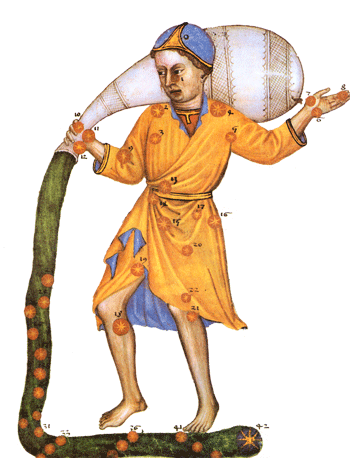
BIBLIOGRAPHY
AA.VV., The Cambridge Encyclopaedia of Astronomy, London 1977. It. transl. by Libero Sosio, Enciclopedie Cambridge. Astronomia. Bari 1981.
Anonymous 379 AD, CCAG V / 1, p. 194-211, Bright, passionate, harmful and helpful stars, Italian translation by Giuseppe Bezza, English translation by Daria Dudziak http://www.cieloeterra.it/eng/eng.testi.379/eng.379.html
Antiochus of Athens, CCAG VII, p. 111, Dei gradi di infermità nei segni, It. transl. by G. Bezza, www.cieloeterra.it/testi.antioco1/antioco1.html
Bezza G., Commento al primo libro della Tetrabiblos di Claudio Tolemeo, Milano 1990.
- Arcana Mundi. Antologia del pensiero astrologico antico, Milano 1995.
Burnham R. Jr., Burnham’s Celestial Handbook. An observer’s guide to the universe beyond the solar system, Flagstaff, Arizona 1966, New York 1978 (3 voll.).
Chambers G. F., Descriptive astronomy, Oxford 1867.
Dimai A., D’Arsiè F., Nuzzo R., Rosolen G., Profondo Cielo, Galliera Veneta 1995.
Ferrari A., Stelle, galassie e universo. Fondamenti di astrofisica, Milan 2011.
Foderà-Serio G., Indorato L., Nastasi P, Hodierna’s Observations of Nebulae and his Cosmology, Journal of History of Astronomy V.16 n.1/feb, p. 1 (1985).
Hevelius Joannes, Firmamentum Sobiescianum, sive uranographia, in Prodromus astronomiae, Danzica 1690.
Hirsfeld A., Sinnot R.W., Sky Catalogue 2000.0, vol. 1: Stars to magnitude 8.0, Cambridge University Press & Sky Publishing Corporation, 1982.
Hodierna G. B., De admirandis coeli characteribus opuscula duo, in quorum primo cometarum causaes disquiruntur et explicantur, necnon vie cometarum per orbem cometicum multiplices indicantur. In secundo vero quid, quales, quotue sint stellae luminosæ, nebulosæ, necnon et occultae manifestantur, et rerum cælestium studiosis commendantur, Palermo 1654.
Kunitzsch P., Star catalogues and star tables in medieval oriental and european astronomy, Indian Journal of History of Science, 21(2) 113-122 (1986).
Ptolemy Claudius, Almagest, translated and annotated by G.J. Toomer, London 1984.
- ΚΛΑΥΔΙΟΥ ΠΤΟΛΕΜΑΙΟΥ ΜΑΘΗΜΑΤΙΚΗ ΣΥΝΤΑΞΙΣ. Composition Mathématique de Claude Ptolémée, traduite pour la première fois du grec en français sur les manuscrits originaux de la bibliothèque impériale de Paris, par M. Halma, et suivie des notes de M. Delambre, Paris 1813.
- Tetrabiblos, third book. Unpublished translation by G. Bezza.
- Tetrabiblos, ed. and transl. into English by F.E. Robbins, London 1940, rist. 1980.
Rhetorius, CCAG VIII / 4, pp. 186-190, Configurazioni generali sulle infermità e le malattie, It. transl. by G. Bezza, www.cieloeterra.it/testi.retorio5/retorio5.html.
Ridpath I., The Illustrated Encyclopedia of Astronomy and Space, New York 1979.
Ridpath I., Tirion W., Guide to stars and planets, London 1984. It. transl.
Girolamo Mancuso, Guida delle stelle e dei pianeti, Padova 1986.
Schjellerup H.C.F.C., Description des étoiles fixes composée au milieu du dixième siècle par l’astronome persan Abd al-Rahman al-Sûfi, Saint Petersburg 1874.
Smith W. H., A Cycle of Celestial Objects, for the use of naval, military and private astronomers. Vol. II. The Bedford Catalogue, London, 1844, Richmond, Virginia 1986.
Ufficiale G., Alcuni esempi sulle affezioni visive, «Phôs» 10, June 2005.
DIGITAL RESOURCES
Starry Night Pro Plus 6.2.3, Imaginova Canada 1997-2006.
Phαsis 1.0, classical astrology software, Milano 2011.
History of the discovery of the deep sky objects
Historical deep sky object list, Frommert H., Kronberg C.,
Hodierna's Deep Sky Observations
Atlas Coelestis , Felice Stoppa's site dedicated to the history of celestial cartography.
NOTES
[1] Paper presented at the IV Annual Conference of Apotélesma, held in Genoa October 30, 2011.
[2] The non-stellar objects are all celestial objects other than stars or solar system bodies. Amateur astronomers, who observe the sky with their amateur telescopes, usually call deep-sky objects.
[3] Star clusters are groups of stars held together by their own gravity. They are divided into two very different groups: globular clusters, older, more compact and concentrated, with hundreds of thousands of stars held together by strong gravity, and open clusters younger, with a lower number of stars held together by a weaker gravity .When the gravitational bond is very weak they are called stellar association rather than cluster. Some star clusters are visible to the naked eye, especially the open ones.
The nebulae are clusters of interstellar gas and dust. There are several types: the brightest are the diffuse nebulae that can reflect the light of nearby stars (reflection nebulae) or emit their own light (emission nebulae).
[4] For example Toomer, in his notes to the Almagest, about the Cygnus's knee observes, "ω Cygni is not a nebula, but a multiple star system." See Almagest, translated and annotated by GJ Toomer, London 1984, p. 351.
[5] The open cluster M7 is also known as the Ptolemy's cluster.
[6] Tetrabiblos, III.13, unpublished translation by G. Bezza.
[7] The area of the Milky Way between the bow of Sagittarius and the tail of Scorpio is full of bright star clusters. The M8 cluster, the Lagoon Nebula with NGC 6530 is the brightest after M7, the sting of the Scorpio. M8 is about 6 degrees above the bow of Sagittarius, which is the star γ, Al-Nasl, but its longitude is the same, so the assignment of M8 to the "arrow of Sagittarius" leaves no room for doubt.
[8] Ptolemy here seems to proceed by constellation, identifying the most nebulous of each image of the zodiac. Among the numerous nebulae of Sagittarius, M8, the one above the arrow, is much larger and brighter than the small asterism in the eye.
[9] The zodiacal belt is certainly the most significant area of the sky, because the Moon can be very close to the nebulae present or even can overlap them, as in the case of Praesepe, the Pleiades, the Arrow of Sagittarius. However, the astrologer should carefully go over the wording of the Ptolemaic text and should not forget objects far from the ecliptic, provided that they are able to rise and set, thus participating to the diurnal motion with the luminaries and planets, with whom they can can form mundane figures. Ptolemy himself (Alm. VIII.4) explains that configurations of stars occur in three ways: the first compared to the luminaries and planets along the zodiacal belt, the second with respect to a given horizon of the earth, when they are in one of the four angles, and the third with respect to the celestial bodies and the the horizon at the same time, when they arise, culminating or set together, and when they are away from the meridian the same amount of temporal hours, or when they are on the same hourly circle.
[10] For the correspondence between every degree of azemena and the nebulous areas of the zodiac, cf. the Tavola dei gradi di azemena, in www.cieloeterra.it/strumenti/gradiazemena/azemena2000.html
[11] CCAG VII, p. 111, Dei gradi di infermità nei segni,ranslation by G. Bezza, www.cieloeterra.it/testi.antioco1/antioco1.html
[12] CCAG VIII/4, pp. 186-190, Configurazioni generali sulle infermità e le malattie, translated by G. Bezza,
www.cieloeterra.it/testi.retorio5/retorio5.html
[13] CCAG V/1, pp. 194-211, Stelle lucide, passionali, nocive e soccorritrici, translation by G. Bezza,
http://www.cieloeterra.it/eng/eng.testi.379/eng.379.html
[14] Since the undoubted stellar origin of azemena degrees, we can consider this list as one of the best examples of that rough practice to which Ptolemy did not acquiesce: to reduce and measure the celestial phenomena in ecliptical degrees. Saying that along the zodiac there is a greater luminous virtue because it is transited by the celestial bodies, is not the same as saying that all measurements should be made in ecliptical degrees . The conjunction of the Moon with a star is not measured by longitude but according to simultaneous transits in the diurnal rotation.
[15] The Andromeda galaxy is the most striking absence in Ptolemy's catalog. Al Sufi describes it as «a small cloud very close to the star no. 14 [of Andromeda constellation], on the right side».
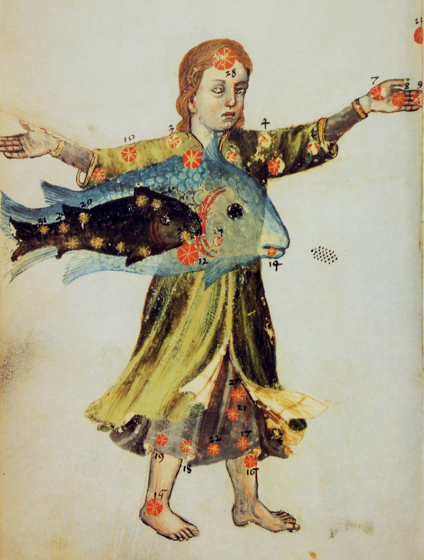
[16] Galileo was the first to distinguish Præsepe in its stars, a few years before Hodierna's observations.
[17] The Hyades have been known since ancient times but no one had ever considered them as a nebula. In the text of the Anonymous of 379 AD they are among the "passionate stars" but not among asterisms harmful to the eye. See G. Bezza, Arcana Mundi.Antologia del pensiero astrologico antico, 1995, p. 453 et sq.
[18] In fact we know that stars are joint to planets and angles according the identity of transit in the diurnal rotation and not simply by overlapping or closeness. See footnote 9.
[19] The visibility limit of a star to the naked eye in perfect sky conditions is between the magnitude 6.0 and 6.5, according to the vision capability of the observer.
[20] The magnitude of the stars today is measured with great accuracy by means of photoelectric techniques. These techniques also allow to calculate the integrated magnitude of celestial objects with an extended surface (star clusters, nebulae, galaxies) that is the magnitude the object would have if all the emitted light came from a single point, as in the case of a star . For these objects can also be calculated the average surface brightness, expressed in magnitude per square arc-minute, with the formula AM= I + 2.5 log a, where I is the integrated magnitude and a is the surface in square arc-minutes. For example, Andromeda galaxy (M31) has an integrated magnitude of 3.47, an area of 178 'x 63' = 11,214 square minutes, and an average surface brightness of 13.59. The calculation of the magnitude of surface loses its meaning, however, in the case of star clusters, as for example Pleiades , which have not a more or less homogeneous light emission surface, and even more in the case of small asterisms.
[21] Assuming a magnitude limit value different than 8, of course the index will change, because in the considered area we would have a different number of stars. The limiting magnitude 8, on which we have set this method, is suitable for almost all the known nebulae. However, there may be instances beyond this limit, such as the open cluster NGC 752 in Andromeda constellation: this cluster, probably discovered by Hodierna, is visible to the naked eye in the clearest nights as a faint halo at North of Triangle, and is composed of about 40 stars of magnitude 9 and 10. In a case like this, it is necessary to raise the magnitude limit to 10 and recalculate the index on the actual stars.
[22] In the case of Hyades and Coma Berenices, we considered only the brightest part of the cluster. The Hyades, in their full extension, are a very large mass, about 20 square degrees, and the index is thus considered to be rather low. But inside there is a smaller area, in the proximity of the star θ1 and θ2, which presents a much greater concentration of light in a slight lesser area than Pleiades. The whole Coma has an area of nearly 40 square degrees and, taken as a whole, gets a lower index than Milky Way.
[23] See Appendix 2. The need to extend the influence of the nebulae beyond the Moon has been already reported by Giancarlo Ufficiale in Alcuni esempi sulle affezioni visive Phos no. 10 June 2005. Ufficiale found the nebulae «not always with the luminaries, but sometimes at the horizon or with the harming malefic, or at least in sensitive points of the nativity. Also it seems they are effective not only by presence, but also by opposition. And this both in nativities, and in the two preceding moments, syzygy and conception».
[24] The orbit we have accepted in all these examples is 3 transit degrees. However, for larger objects is reasonable to consider wider orbits, which can reach up to 6 degrees in Coma Berenice's case. In this case, the distance between the cluster center and the Moon is about 5 degrees.
[25]G. Ufficiale, op. cit., p. 10 ff.
[26] Between Praesepe and Mars there are 8 transit degrees but the nebula is angular and the malefic in sixth has not yet separated from the angle.
[27] This information comes from the web ( http://www.answers.com/topic/rahsaan-roland-kirk ): Blind from the age of two, Kirk reported in Ebony «I think a nurse put too much medicine in my eyes, and my mother did not find out about it until too late».
[28] The whole table of the presence of nebulae in the 18 scrutinized examples is shown in Appendix 1.
[29] See footnote 21. Increasing the magnitude limit to 10 we have identified three other open clusters with a significant index: NGC 6025 in the Southern Triangle, NGC 752 in Andromeda (note 21) and M48 in Hydra. These objects are visible to the naked eye with great difficulty, and none of them appear in the 18 scrutinized examples.
A further investigation on nebulae should primarily focus on nativities in the Southern Hemisphere, of whom we have been able to find only an example, the n. 12.
